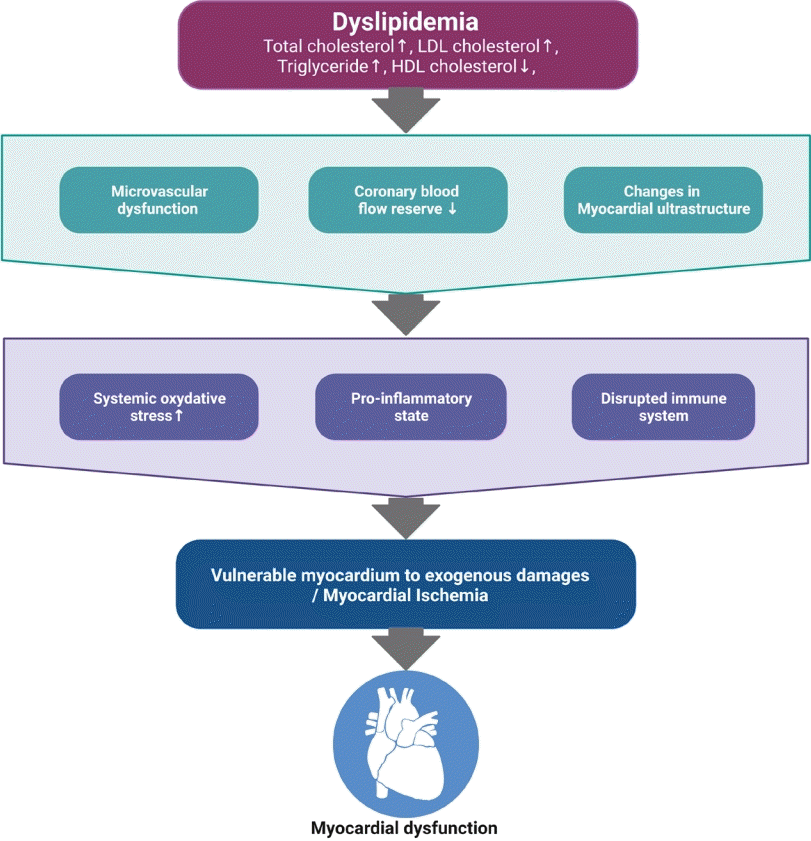Early echocardiographic screening for subclinical myocardial dysfunction in children and adolescents with dyslipidemia: why and when?
Article information
Key message
Dyslipidemia contributes to early atherosclerosis, premature cardiovascular disease, and subclinical ventricular dysfunction in children. This paper highlights the need for echocardiographic evaluation for impaired diastolic function of both ventricles and narrowing of the aortic valve and sinus of Valsalva. Therefore, early echocardiographic screening of children with primary hyperlipidemia should be considered.
Graphical abstract.
Dyslipidemia is closely related to cardiovascular disease (CVD) in adults and children and adolescents. As the prevalence of obesity and metabolic syndrome in children increases, the progression of CVD may occur at a younger age. In the issue of Clinical and Experimental Pediatrics, El-Koofy et al. [1] presented an association between primary dyslipidemia and myocardial dysfunction in early childhood. Primary dyslipidemia is mainly familial and manifests in childhood, and disease severity is usually worse than that of secondary dyslipidemia. Although the authors analyzed a small number of patients (25 patients), which limits the study’s power, considering that primary dyslipidemia in children is a relatively rare condition, this analysis is still valuable. This study’s main strength is that it stresses the importance of recognition and screening for myocardial function using early echocardiography in children and adolescents.
Universal screening for all children has emerged as a new concept over the last decade in contrast to the previous strategy of screening children and adolescents based on risk factors alone [2]. According to the clinical practice guidelines for dyslipidemia in Korean children and adolescents published in 2017 [3], in children aged 1–9 years with a family history of early coronary artery disease or dyslipidemia, screening for dyslipidemia using lipid profiles in a nonfasting state is recommended. The cholesterol level generally decreases by 10%–20% during puberty and increases again in the 20s [4]. Therefore, considering this pattern, screening blood tests for dyslipidemia are required at 9–11 years of age and at 17–21 years for all children and adolescents, even if a clinical family history is lacking [3]. However, there are still no clear guidelines for the timing of screening for CVD using echocardiography [5].
Dyslipidemia contributes to early atherosclerosis and premature CVD [6,7]. It is known that increased total cholesterol, low-density lipoprotein cholesterol, and triglyceride levels and a decreased high-density lipoprotein cholesterol level are involved in the microvascular function that is correlated to myocardial function [8]. Hypercholesterolemia decreases coronary blood flow reserve, making the myocardium more vulnerable to exogenous damage such as hemodynamic overload and myocardial ischemia [9]. Furthermore, hypercholesterolemia may also result in changes in the myocardial ultrastructure through several mechanisms, ultimately impairing ventricular function. In an experimental rat model, it led to systemic oxidative stress and a proinflammatory state [10]. It disrupts the immune system and induces the production of autoantibodies for G protein-coupled receptors, increasing myocardial vulnerability and aggravating heart damage [11]. It also significantly decreased the expression of the cardiac autophagy markers [12]. As reported in previous studies, further studies are needed that screen for myocardial function in children and adolescents with dyslipidemia.
A previous study highlighted the need for echocardiographic evaluation upon identifying impaired diastolic function of both ventricles and narrowing of the aortic valve and sinus of Valsalva [1]. The authors arrived at this conclusion by measuring the M-mode, 2-dimensional, pulse-wave, and color Doppler blood flow velocity measurements of the heart valves. In addition, functional parameters, including ejection fraction, peak systolic and early/late diastolic velocities, and global myocardial performance index, were measured. These parameters are commonly measured and used in the clinical setting. In addition, as previously reported, mechanisms of myocardial change, impaired diastolic function, and changes in heart valve size are possible consequences of dyslipidemia [13]. Although it is well known that dyslipidemia is associated with premature CVD and myocardial dysfunction, limited guidelines mention the need for echocardiography in children and adolescents with dyslipidemia. Echocardiography is still an advanced diagnostic modality in many countries, as its cost is high and specialists are required to perform it. Nevertheless, experts in the field should discuss the specific guidance for performing echocardiography and the parameters that must be obtained for children and adolescents with dyslipidemia.
Early recognition and intervention for dyslipidemia in children and adolescents are essential for preventing severe CVD in adulthood. As recent evidence indicates that dyslipidemia leads to myocardial dysfunction, echocardiography screening for subclinical ventricular dysfunction in children with dyslipidemia should be considered. Early echocardiographic screening for CVD and myocardial dysfunction in children with dyslipidemia requires discussion and further study. Future studies will elucidate the timing of lipid-lowering agents that reverse early ventricular dysfunction, thus decreasing morbidity and mortality rates.
Notes
Conflicts of interest
No potential conflict of interest relevant to this article was reported.
Acknowledgements
The graphic abstract was edited by Biorender.

